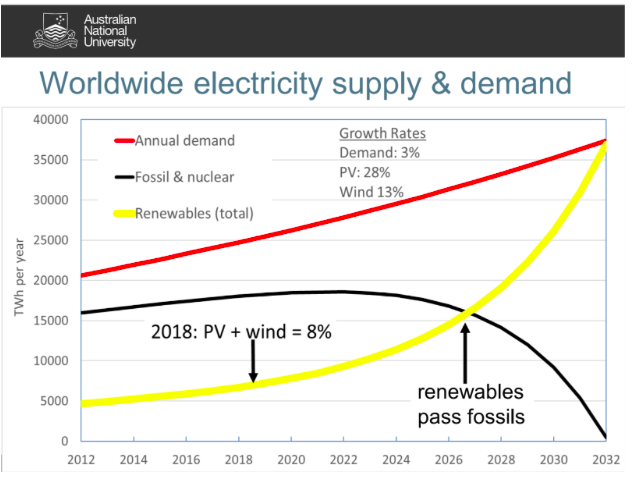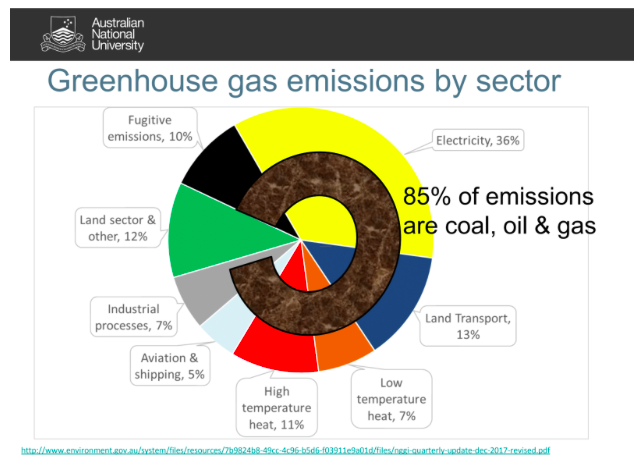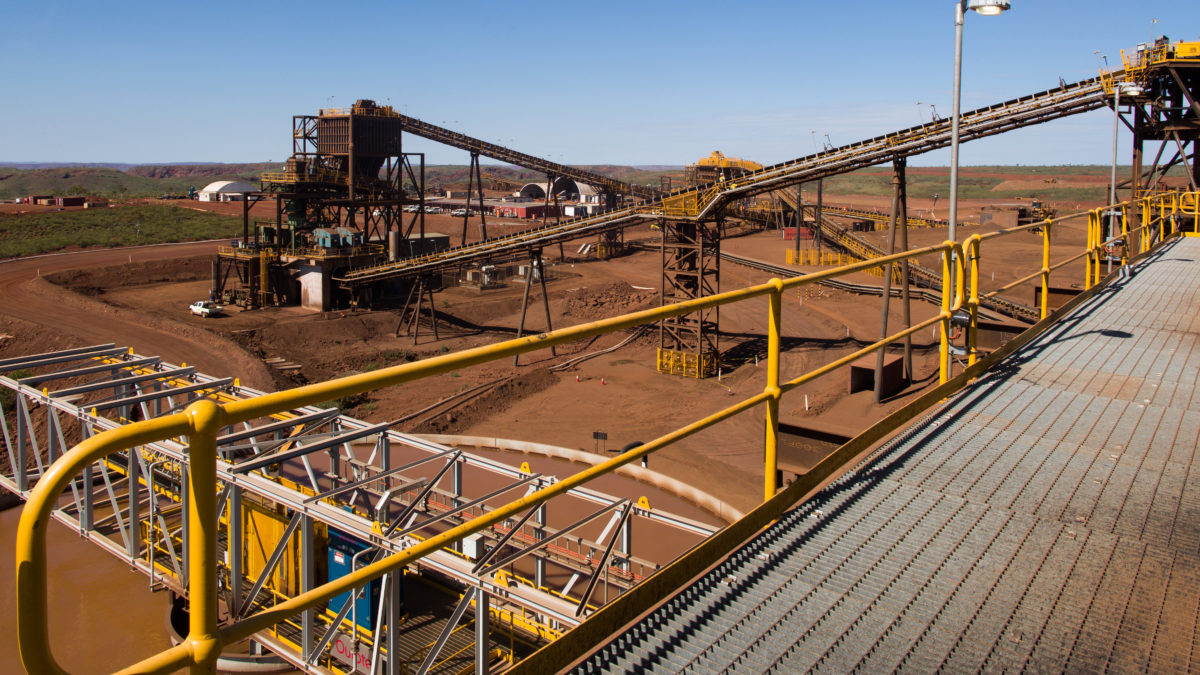In a presentation to the 2018 Asia-Pacific Solar Research Conference this month, Andrew Blakers, Professor of Engineering at Australian National University made the case for massive deployment of solar PV in the Pilbara to decarbonise the making of steel, adding value to our biggest export so that it can “replace the coal and gas that we’re not going to be exporting in the future”.
Overall, Blakers’ presentation argued that Solar PV is the only practical path to rapid climate stabilization. “Solar just needs to continue growing. The technology is all there. The scale is there.”
The world is already producing 100 GW of solar energy a year, Blakers says, “We need to push that up to 2000 GW per year and that will be enough to push all oil, gas and coal out of the entire energy system.”
In fact, he says if growth of wind (13% per annum) and solar PV (28% pa) continue at current rates, compounding year on year, and global demand for electricity continues at 3% per annum, fossil fuels could be redundant by 2032.

It’s not a prediction, emphasises Blakers, but an extrapolation: “It’s saying that if what has happened over the past few decades continues into the next few decades, then we’ll have very high levels of renewable electricity rather quickly.”
In particular, he says that if solar PV continues to grow — “it’s already the No. 1 new-generation technology” — it will take over as the lowest-cost generator of electricity, forcing coal-, oil- and gas fired electricity generation into retirement.
“The silicon solar cell has been and continues to be the bedrock of photovoltaics, it’s 95% of the global solar market, and efficiencies are just gradually creeping up,” says Blakers, which means the cost of solar-generated energy keep getting lower.
Opportunity rocks
Blakers calculates that to process Australia’s iron ore exports into high-grade iron or steel before it leaves the country would require six times Australia’s current total electricity output, and that the Pilbara’s solar and wind resource can easily supply the energy needed.
Western Australia’s Department of State Development estimates WA’s exports of iron ore for 2018 will be around 800 million tonnes, which is around 94% of Australia’s production, and 37% of global production.
The opportunity, says Blakers, is to plan for processing iron ore at strategic sites between the mines and the main ports of Dampier, Cape Lambert and Port Hedland, using renewable energy.
It’s a logical step in the drive to radically reduce carbon emissions and arrest global warming, says Blakers. Electricity production currently makes up 36% of greenhouse-gas emissions. Once electricity production is powered exclusively by renewables, and land transport (responsible for 13% of emissions) has been electrified; once high-temperature heating, currently powered by gas (11% of emissions) and low-temperature heating (7%) are fully powered by renewables — the reduction in carbon emissions will be around 66%.

Graphic: Professor Andrew Blakers/ANU
“That leaves several significant sources of emissions to be electrified — one of them is iron and steel production,” says Blakers. The most basic processing of iron ore uses coking coal — an almost pure-carbon product of heating coal under extremely high temperatures — to draw the oxide from the ore, producing carbon dioxide as a byproduct. Instead, he says you can mix iron-oxide with hydrogen so you end up with iron, and steam as the bi-product.
“It’s a clean process, provided the hydrogen comes from a clean source, such as electrolysis of water. In that way you are essentially electrifying the steel industry.”
Hydrogen production from renewables in the north of Australia, and the potential for green hydrogen exports is developing is developing momentum, with the IEA pointing to its potential in its latest World Energy Outlook publication.
Even without taking the opportunity to renewably power iron and steel production, thereby creating exports of a higher value for Australia than simply shipping ore, Australia is on track to achieve deep emissions reductions, says Blakers.
Per capita, Australia is the world leader in renewable energy penetration
“Australia is absolutely the pathfinder nation for moving rapidly to high levels of renewable electricity. Everyone else is miles behind us in terms of per capita speed,” says Blakers. “In Australia wind and PV are being deployed five times faster per capita than in Europe, China and in the United States.”
Blakers believes that the pace of Australia’s renewable development will be sustained without further direct government incentives, “We have 15 GW of PV and wind more or less locked in over 2018 through 2020. And there’s no reason to think it will suddenly stop in 2021.”
However government policy will still be important to assist the rollout of stronger interconnection and storage: “That’s where federal and state governments have to focus,” says Blakers. If Snowy 2.0 is approved by government, “it takes care of most of the storage needs out to say 2024, and then we’ll need more storage after that.”
And although strengthening transmission is a part of the development of Snowy 2.0, Blakers says government has a significant role in increasing interstate interconnection to even out the differences in weather patterns, and therefore renewable output, from one region to the next.
Given the right infrastructure conditions, Blakers says, “The private sector can be relied upon to build wind and PV to saturate any provided storage and transmission.”
Natalie Filatoff
This content is protected by copyright and may not be reused. If you want to cooperate with us and would like to reuse some of our content, please contact: editors@pv-magazine.com.








5 comments
By submitting this form you agree to pv magazine using your data for the purposes of publishing your comment.
Your personal data will only be disclosed or otherwise transmitted to third parties for the purposes of spam filtering or if this is necessary for technical maintenance of the website. Any other transfer to third parties will not take place unless this is justified on the basis of applicable data protection regulations or if pv magazine is legally obliged to do so.
You may revoke this consent at any time with effect for the future, in which case your personal data will be deleted immediately. Otherwise, your data will be deleted if pv magazine has processed your request or the purpose of data storage is fulfilled.
Further information on data privacy can be found in our Data Protection Policy.